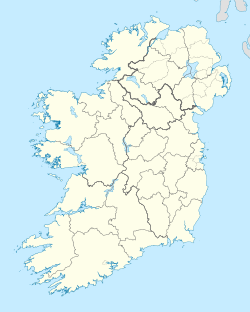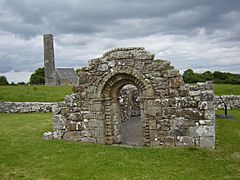Inis Cealtra facts for kids
|
Nickname: Inishcaltra / Holy Island
|
|
|---|---|

St. Caimin's and Brigid's churches
|
|
| Geography | |
| Location | Lough Derg (Shannon) |
| Coordinates | 52°54′54″N 8°27′0″W / 52.91500°N 8.45000°W |
| Administration | |
| Province | Munster |
| County | Clare |
| Demographics | |
| Population | 0 |
Inis Cealtra, also known as Inishcaltra or Holy Island, is a special island in Lough Derg, Ireland. It is now empty of people, but it was once a busy place where monks lived and studied.
The island has an old Irish round tower and the remains of several small churches. You can also find four tall high crosses and a holy well here. Even though no one lives on the island, its cemetery is still used today. Families bring coffins and mourners by small boats from County Clare to bury their loved ones. You can visit Inis Cealtra by taking a boat trip from Mountshannon. The East Clare Heritage Centre helps to protect this historic island.
Contents
Discovering the Island's Past
Inis Cealtra has a long and interesting history. It was a very important religious center in early Ireland.
Early Beginnings and Monasteries
Around the year 520 AD, a holy man named St. Colum started a monastery on Inis Cealtra. Later, in 653 AD, St. Caimin founded a second monastery. This monastery became a famous school where many people came to learn. St. Caimin was also a bishop and the leader of the monastery.
Viking Attacks and Changes
The island faced tough times when Vikings attacked it. In 836, a Viking leader named Turgesius attacked, and many monks were killed. Another Viking attack happened in 922.
Marcán, who was the brother of the famous Irish king Brian Boru, was a bishop and leader of the monastery on Inis Cealtra until his death in 1003. After the Reformation, which was a big change in religion, the religious buildings on Inis Cealtra were no longer used.
Island's Location Over Time
For a long time, Inis Cealtra was part of County Clare. This was even though the nearby mainland was in County Galway. In 1849, the island was moved to County Galway to make county borders simpler. However, in 1899, the island and the nearby mainland were moved back to County Clare.
Exploring the Old Buildings
Inis Cealtra is full of old ruins that tell stories of the past.
The Pilgrim's Path
The pilgrim's path is a low, curved earthwork. It connects two important old churches: St. Caimin's Church and St. Michael's Church. Pilgrims, or religious travelers, would have walked this path.
The Baptism Church
The small Baptism Church is built in the Romanesque style. It is surrounded by a stone wall. The church was damaged in a big storm in 1839. It was later rebuilt and used as a house and even a metal workshop.
St. Caimin's Church
St. Caimin's Church is the only building on the island that still has a roof. Some parts of it are from the 10th century. In the 12th century, a beautiful Romanesque doorway was added. This doorway has been rebuilt several times over the years. Inside the church, you can see old crosses, monuments, gravestones, and a sundial.
St. Mary's Church
The ruins of St. Mary's Church are from the 13th century. Inside, you can find old graves and a tomb belonging to the O'Brien family.
St. Michael's Church
St. Michael's Church is what we call the remains of a small building that was likely a church. Old maps call it "Garaidh Mhichaeil," which means "Michael's garden." It was probably a cillín, which was a special burial ground for babies who had not been baptized.
The Round Tower
The Round Tower on Inis Cealtra was studied and repaired between 1970 and 1980. The very top, or cone-cap, of the tower was never found. This suggests that the tower was never fully finished. There's a legend that a beautiful witch distracted the stonemason, so he couldn't finish his work!
The Saints' Graveyard
You enter the Saints' Graveyard through a graveyard from the 1800s. The grave markers inside are from the 11th century and are written in Irish. Outside the graveyard walls is a stone structure called the confessional. Its original use is not known, but it was used for confessions in the 18th and 19th centuries. It was rebuilt in 1979.
Bullaun Stones
There are five special Bullaun stones found on the island. These are large stones with bowl-shaped hollows carved into them. Their exact purpose is still a bit of a mystery.
Important People Connected to the Island
Many interesting people have connections to Inis Cealtra.
- Saint Donatus of Fiesole was a teacher, poet, and bishop. He received his education right here on Inis Cealtra.
- The building of St. Caimin's Church and the round tower are often linked to Brian Boru, one of Ireland's most famous high kings.
- The wife of Toirdelbach Ua Briain, another important Irish leader, was buried on the island in 1076.
- The famous poet William Butler Yeats (1865-1939) lived near the island for a while. He wrote about Inis Cealtra and Lough Derg in his poem The Pilgrim.




